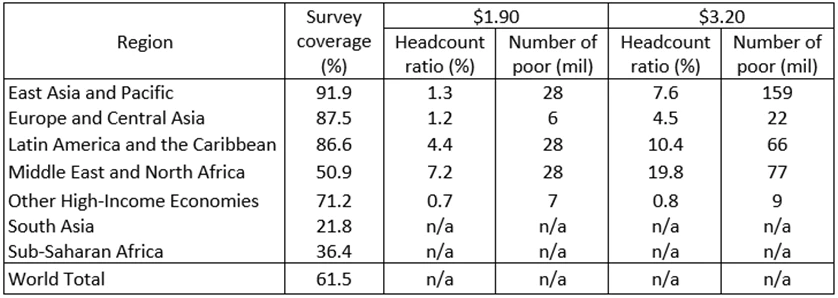The March 2020 global poverty update added more than 200 new surveys to PovcalNet, bringing the total number of surveys to more than 1,900. New poverty estimates for the reference year 2018 are now included for some regions, and the previously published global and regional estimates from 1981 to 2015 have been revised, reflecting data revisions and the availability of new data. More details on the revisions can be found in Atamanov et al. (2020).
The table below shows the poverty estimates in 2018 for the regions where we have sufficient data. The data available at the time of the March 2020 update do not offer sufficient population coverage in 2018 for South Asia and Sub-Saharan Africa, so we are unable to publish regional poverty estimates for these two regions. Since these regions account for most of the global poor in recent years, we are also unable to provide a global poverty estimate for 2018 at this time. As further survey data in these two regions become available, we will update PovcalNet such that we can provide a global poverty estimate in the upcoming Poverty and Shared Prosperity report (to be published in the Autumn of 2020).
The absence of a poverty number for the world and the two poorest regions starkly illustrates that our ability to monitor global poverty relies on national statistical agencies publicly releasing credible household survey data (also see the discussion of data deprivation here). In particular, in two of the countries with the most extreme poor in recent years, India and Nigeria, we rely on household survey data that predate the reference year 2018 by more than six years (in Nigeria the last survey is from 2009/10, while in India it is from 2011/12).
Table 1. Poverty estimates for reference year 2018, different poverty lines
Source: PovcalNet, also accessible through the R and Stata packages
Note: Survey coverage is assessed within a two-year window either side of 2018. Estimates for South Asia and Sub-Saharan Africa are not displayed since these regions have a coverage less than 40%.
East Asia and Pacific has continued its downward trend, reducing the poverty headcount ratio at the international poverty line from 2.3% in 2015 to 1.3% in 2018, driven by decreases in poverty in China and the Philippines. In contrast, spurred by the conflicts in Yemen and Syria, the Middle East and North Africa region has seen a sharp reversal, with the poverty rate increasing from around 2.4% in 2011-2013 to 3.8% in 2015 and 7.2% in in 2018. In Latin America, poverty has largely stagnated, increasing slightly from 4.1% in 2015 to 4.4% in 2018, partially due to an increase in the number of poor in Brazil.
Previously, PovcalNet produced poverty numbers for a new reference year with a three-year lag. For example, in 2018, we released global poverty estimates for 2015. There has been a growing interest in timelier poverty estimates to provide a more up-to-date picture of poverty around the world. The main trade-off weighing against improved timeliness is the added imprecision in the reference-year poverty estimates: The closer the reference year is to the present time, the further we have to extrapolate survey-estimates forward in time. The analysis summarized in Atamanov et al. (2020), suggests that the error in the global poverty headcount rate (at the international poverty line) is likely to increase somewhere in the range of 0-0.6 percentage points, with 0.15 percentage points being our best guess. We judge this to be small enough to merit advancing the line-up year and are reporting poverty estimates for 2018 with this update.
The updated data can be accessed through the website, R and Stata packages. Updated information on comparability of surveys over time is available here (also see this blog and replication code). The World Bank’s global poverty update requires inputs from a large team, who are acknowledged as authors of the What’s New. Furthermore, we would like to thank the countless World Bank Poverty Economists that have provided data and documentation; without them the database of household surveys that underpins these estimates would not exist.







Join the Conversation